LEARN / ARTICLE
CAZ Stories: Air Pollution Levels at TK Cita Pelangi School Significantly Reduced by 94%
CAZ Stories is a series of articles highlighting the significant impact of Clean Air Zones in diagnosing and mitigating indoor air quality issues for businesses in Indonesia. For more information, read our previous CAZ Stories:
- AC Ventures
- Mighty Minds Preschool
- Global Shipping Company
- Mazars Indonesia
- IShine Kelapa Gading
- YCAB Foundation
- New Zealand School
- Kinderfun Preschool
- HEI Schools
- Green Montessori School
- Neuro Care by Klinik Pintar
- Champ Camp
- Hill & Knowlton Strategies Indonesia
- ISMILE Preschool Permata Hijau
- Islamic Village School
Air pollution is a problem impacting communities worldwide, including Indonesia. Especially in cities with high pollution levels like Jakarta, where the average pollution level in 2023 reached up to 38 µg/m3. This condition is unsafe for residents as the pollution far exceeds the annual National Ambient Air Quality Standard (15 µg/m3) and is nearly 8 times higher than the WHO annual guideline.
The WHO designates PM2.5 as a hazardous pollutant due to its small size, making it easily inhalable into the lungs. PM2.5 poses a threat to the general population, but its risks are significantly higher for sensitive groups, including children under five and adults over sixty.
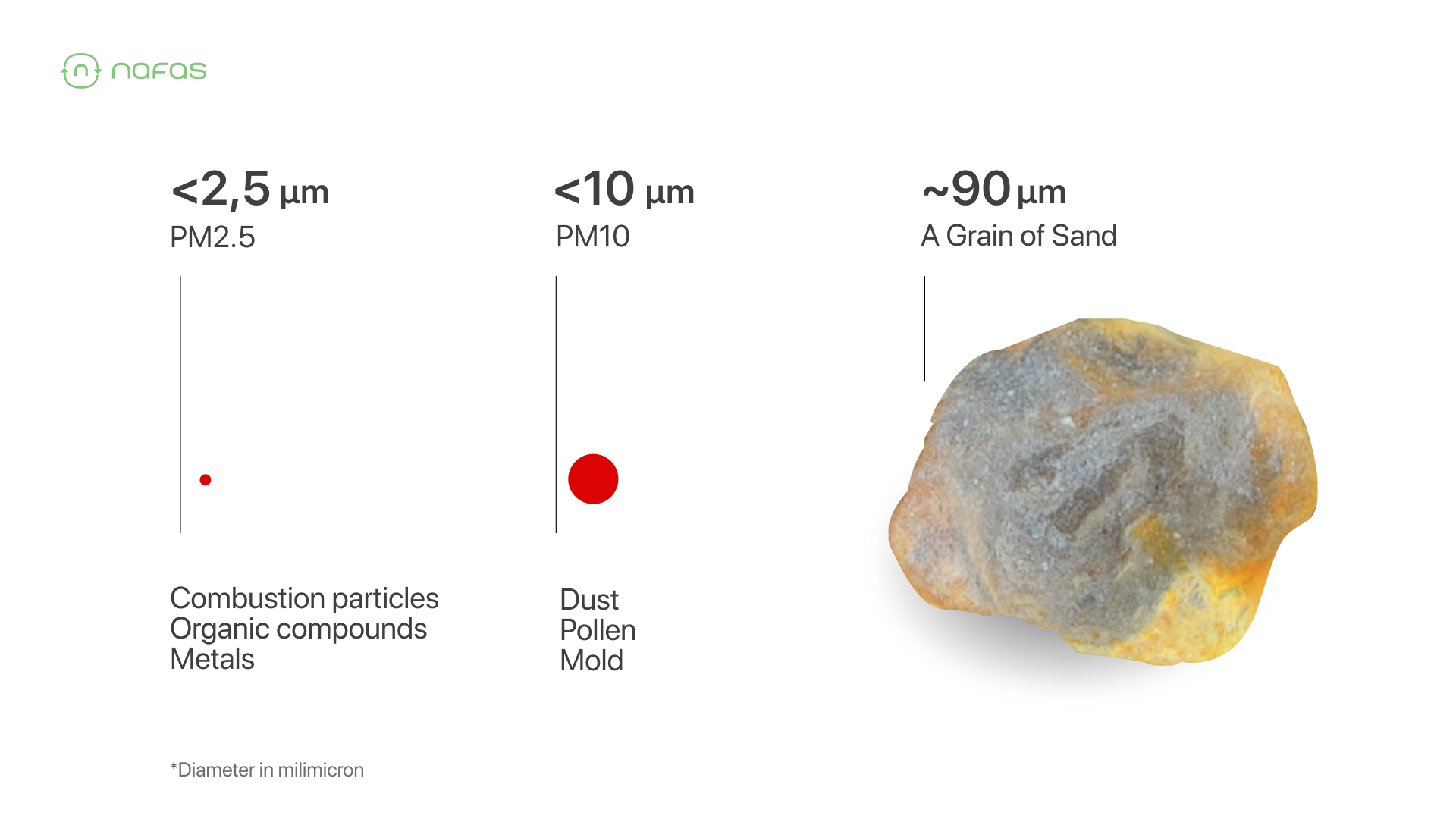
Based on field monitoring by the Nafas team, indoor air pollution leakage from the outside can reach up to 100%. This is concerning, especially for residents in polluted cities like Jakarta.
Recently, Nafas released an article titled "Our Buildings Make Us Sick" highlighting the reality that air pollution is not just an outdoor issue but also an indoor one. In highly polluted cities, indoor air quality is often as high as outdoor air quality, meaning outdoor pollution can seep into buildings and contaminate the air we breathe. This can occur in various buildings, from homes to offices to our children's schools.
Impact of Air Pollution on Children
A study published in the Kosin Medical Journal by researchers from South Korea and Japan investigated the short-term effects of PM2.5 on children. The results revealed a 9% increased risk of asthma attacks in children when PM2.5 concentrations increased by 10 μg/m³ from a baseline of 15 μg/m³ on the day before asthma attacks (Lee et al., 2018).
Aware of this alarming issue, Nafas partnered with TK Cita Pelangi to improve indoor air quality in the school environment to create a healthy learning environment for students, teachers, and school staff.
Issue: Unhealthy Air Quality at TK Cita Pelangi
To assess the extent of indoor air pollution levels in the classrooms of TK Cita Pelangi, Nafas utilized air quality monitors connected to a cloud-based system. These devices monitor PM2.5 levels, CO2 levels, temperature, and humidity.
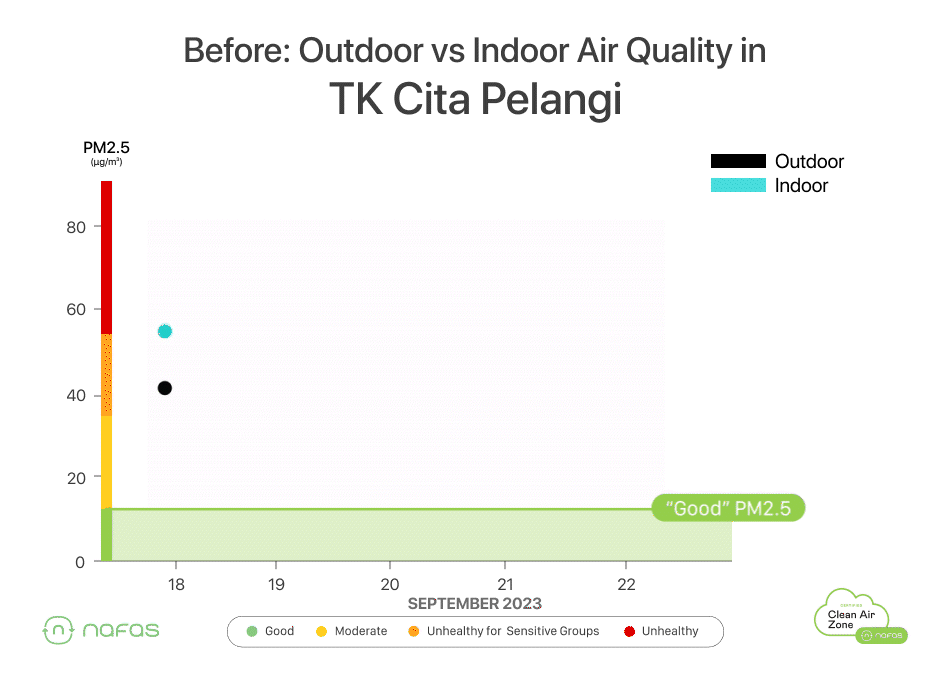
Reviewing data from September 2023, it was observed that air pollution levels consistently remained well above the recommended threshold or 'Good' air quality advised in studies, at the 15 μg/m³ limit.
The highest peak of pollution inside the TK Cita Pelangi classrooms even reached 61 µg/m³, four times higher than the recommended limit.
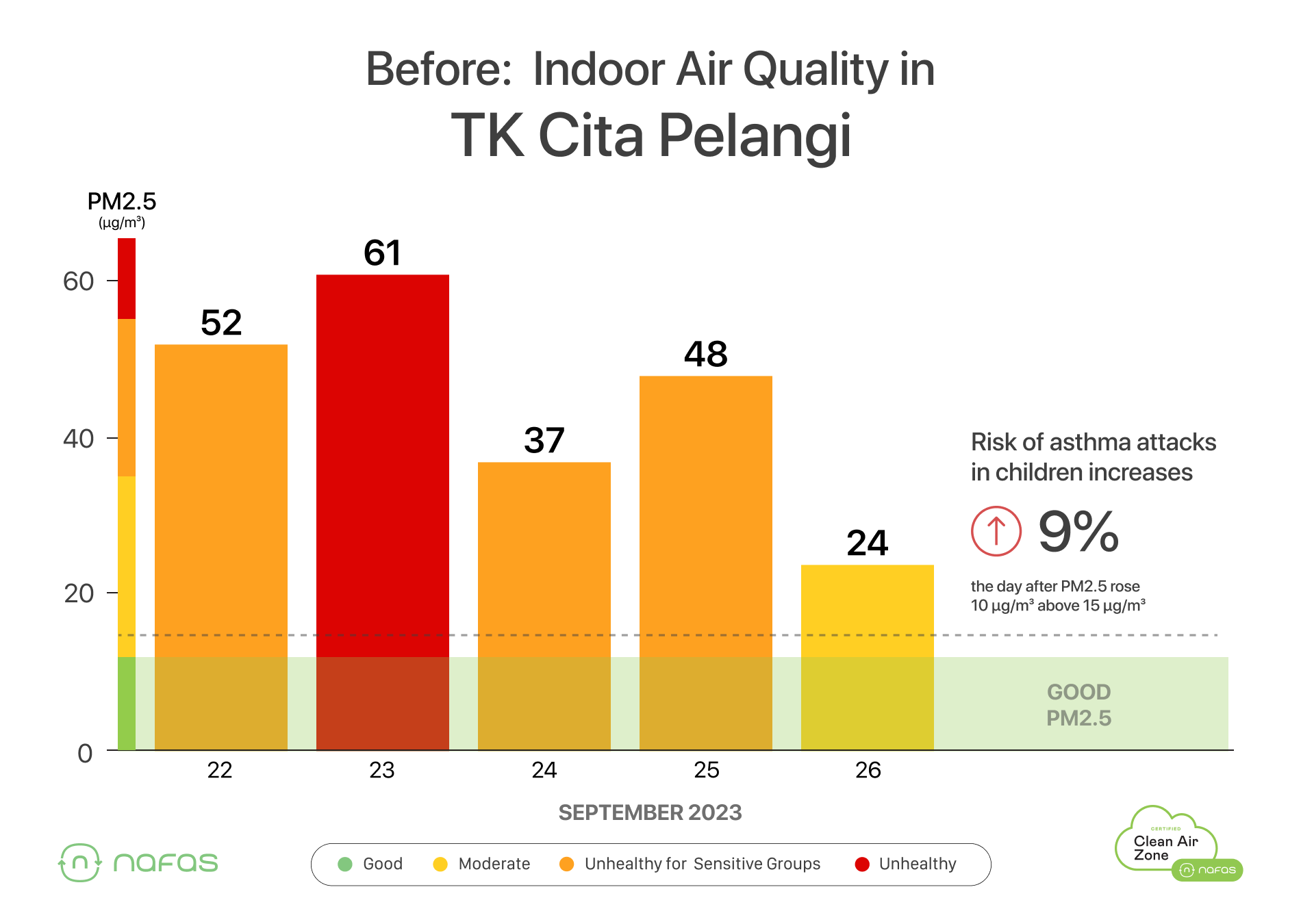
The school building's design is insufficient to filter outdoor air pollution and maintain indoor air health in classrooms. This is concerning, considering children's vulnerability to air pollution. Poor indoor air quality in classrooms can increase the risk of asthma attacks in children. Therefore, interventions such as integrated air purification systems in classrooms are needed to create a healthy learning environment for students, teachers, and school staff.
Solution: Transforming TK Cita Pelangi into a Clean Air Zone
To address poor indoor air quality in buildings in polluted cities like Jakarta, Nafas has developed the Clean Air Zone system. This ecosystem is comprehensively designed to maintain healthy indoor air quality throughout school hours. This can be achieved through an automated and integrated system that includes accurate air quality monitoring, effective air filtration techniques, robust certification standards, and data-driven programs involving stakeholders.
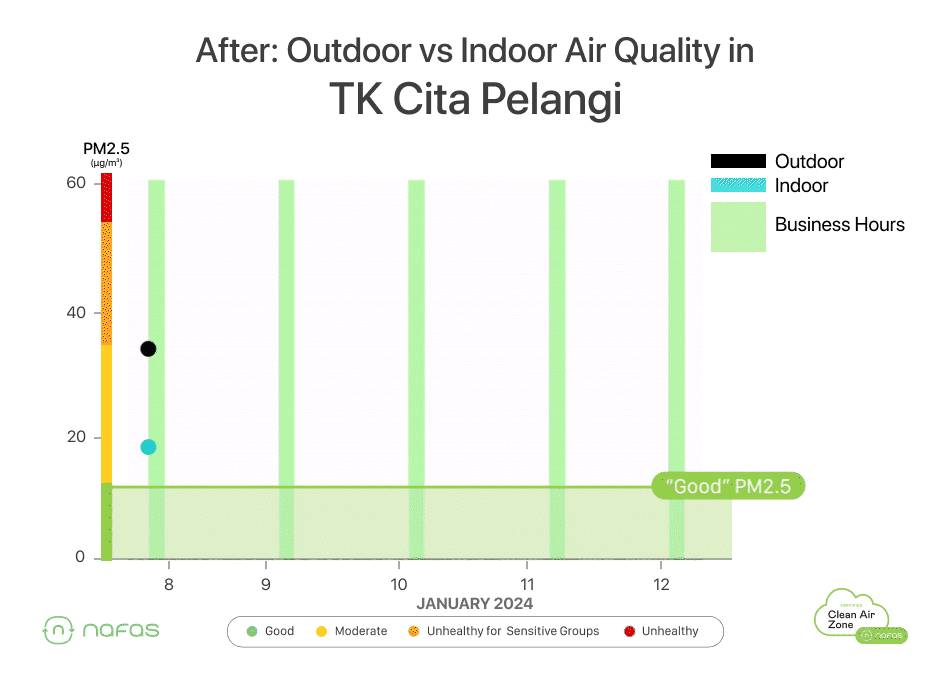
Our services can be obtained through a subscription model without upfront investment. The Clean Air Zone ecosystem can help improve air quality within schools easily and practically.
Results: Significant Improvement in Air Quality at TK Cita Pelangi

TK Cita Pelangi has officially become a Clean Air Zone. The collaboration between the school and Nafas highlights the importance of clean air in classroom environments in schools.
Air quality data collected by the Nafas team during January 2024 showed a significant decrease in indoor air pollution levels in TK Cita Pelangi classrooms after becoming a Clean Air Zone.
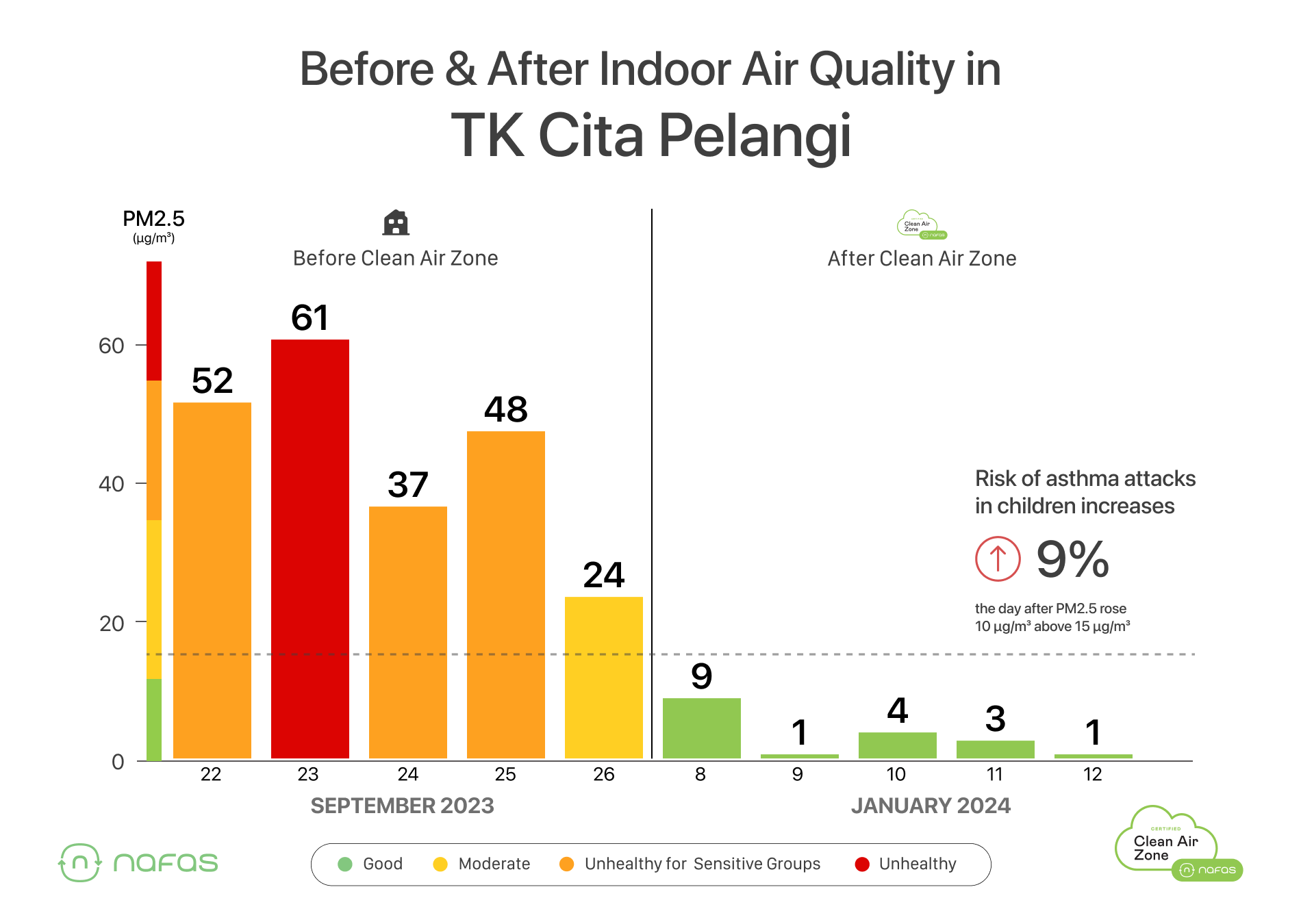
Now, the air quality within TK Cita Pelangi is over 94% cleaner after becoming a Clean Air Zone. Children can breathe cleaner and healthier air during school hours.

Monthly Air Quality Report
Through the data-driven Clean Air Zone service, the school will receive monthly reports containing air quality metrics for the previous month. School leadership can share this information with parents, teachers, staff, and stakeholders, ensuring transparency and encouraging informed participation.
Below is an example of the monthly report received by TK Cita Pelangi:

Becoming a Clean Air Zone is So Easy
Interested in ensuring healthy air quality in your child's school? Feel free to contact us at [email protected] or click the link below to join our mission to make clean air the standard in our children's schools!
